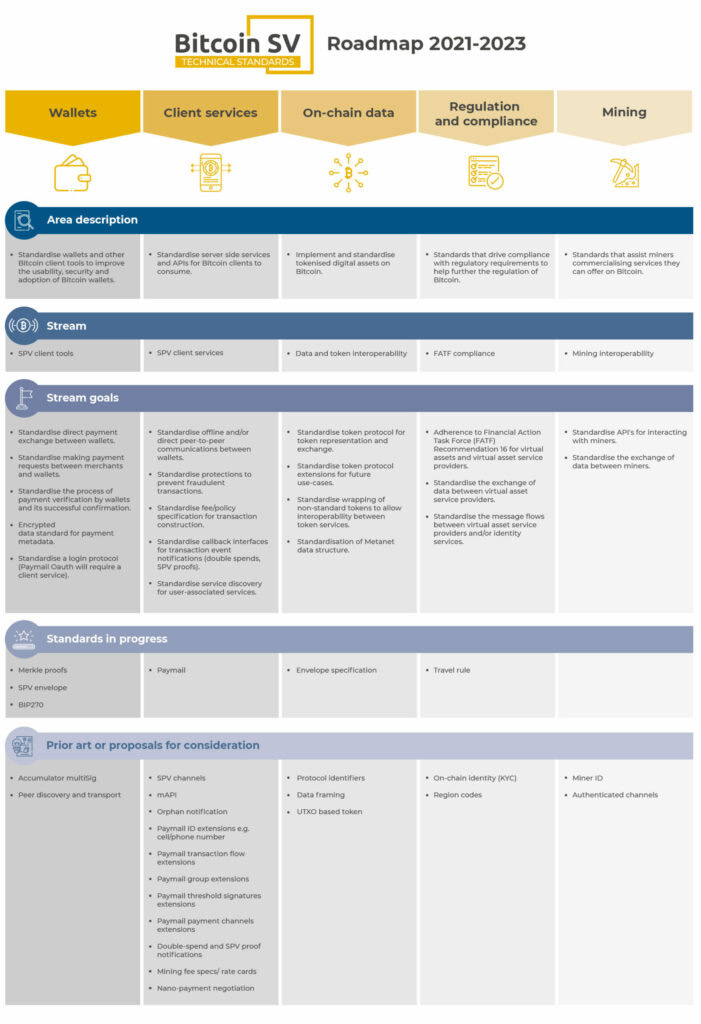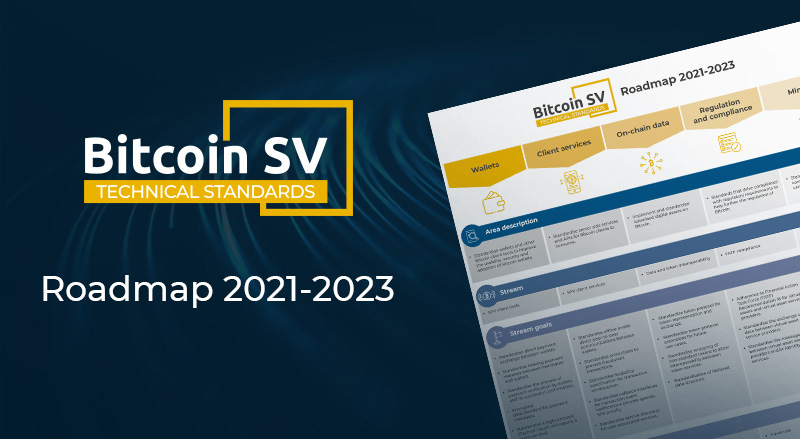The Bitcoin SV Technical Standards Committee (TSC) has officially released its organisational roadmap for 2021-23. The roadmap details the standards that will be considered, proposed, reviewed and implemented by the committee in collaboration with stakeholders in the BSV community.
The primary goal of the TSC, which is supported by Bitcoin Association, is to facilitate industry collaboration through the creation of common technical standards implemented across the BSV ecosystem, and its success relies on the participation of industry stakeholders and businesses within the industry. At various stages throughout the development of the roadmap, the TSC allowed interested stakeholders to submit feedback on the draft roadmap and conducted a public review based on this community interaction.
This feedback and review process served to define the final version of the roadmap, which the TSC notes is a living document that will undergo constant monitoring and assessment. There will be a formal review of the roadmap every six months, and TSC members will continuously review and reassess the priorities of standardisation in response to stakeholder feedback.
The TSC does not determine standards itself – it provides the framework and process for the development of technical standards to improve interoperability and accelerate the adoption of Bitcoin SV.
Roadmap overview
The finalised roadmap categorises technical standards into five key areas: wallets, client services, on-chain data, regulation and compliance, and mining. Each of these categories includes a key stream that describes the focus of standards proposed and created within it. These intra-category streams are as follows:
- Wallets – SPV client tools
- Client services – SPV client services
- On-chain data – Data and token interoperability
- Regulation and compliance – FATF compliance
- Mining – Mining interoperability
As is apparent from the streams described above, the TSC roadmap aims to facilitate interoperability between applications that interact with various important aspects of the blockchain, granting developers working in the ecosystem the ability to compete on product quality and service without becoming siloed off from other environments.
An exemplar for the type of outcome the TSC hopes to realise through its standardisation process is the recently published Merkle Proof standardised format, which describes a way that Merkle Proofs can be requested and provided to SPV clients across the Bitcoin SV ecosystem.
This standard was published under the OpenBSV licence after a thorough review and consultation period. Its publication enables far greater interoperability for BSV payments and provides a stable and reliable platform for building simple payment verification (SPV) services on the blockchain. SPV is an integral component of Bitcoin SV’s core functionality, as it is the blockchain that most closely aligns with the original Bitcoin white paper published by Satoshi Nakamoto in 2008, which describes the application of SPV to enable users to receive and validate payments without running a full Bitcoin node.
The TSC aims to take the same approach with other aspects of the BSV ecosystem, and it has clearly described the standards it aims to pursue under its five key categories in its roadmap. To convey the overarching goals of the committee more easily, we have summarised the five key areas included in the roadmap and the TSC’s standardisation goals for each category.
Wallets
Standardise wallets and other Bitcoin client tools to improve the usability, security and adoption of Bitcoin wallets.
The TSC aims to improve interoperability between Bitcoin SV wallets and SPV clients by proposing and implementing standards which can be easily aligned with by wallet operators and which offer a high level of security and efficiency.
Specifically, the TSC’s roadmap states that several aspects of wallet operations will be prioritised as part of the standardisation process, including direct payments between wallets, payment requests between merchants and wallets, payment verification, encrypting payment metadata and the creation of a standardised login protocol.
Standards in progress under this category include the BIP270 and SPV envelope specification proposals.
Client services
Standardise server-side services and APIs for Bitcoin clients to consume.
This section of the TSC roadmap focusses on merchant and user experience, and the ease of which they can interoperate with different blockchain service providers which provide a range of functions necessary for their efficient operation.
The TSC’s objective in this area is to facilitate the accessibility of SPV client services through standardising how information is communicated between providers and clients. Goals include the standardisation of offline and/or direct peer-to-peer communications between wallets, fraudulent transaction prevention, fee specification for transaction construction, callback interfaces for double spend and SPV proof notifications and service discovery.
Standards in progress or under consideration include Paymail, mAPI, nano-payment negotiation and SPV channels.
On-chain data
Implement and standardise tokenized digital assets on Bitcoin.
The TSC aims to improve accessibility to tokenised digital assets and the ability for these to interact across BSV ecosystem applications by standardising the way tokens are wrapped and how data is written to the blockchain.
Under this category, the roadmap’s goals are to standardise a token protocol for representation and exchange, token protocol extensions for future use-cases, the wrapping of non-standard tokens to facilitate interoperability and the Metanet data structure.
Standards in progress or under consideration include the Envelope specification, a UTXO-based token and protocol identifiers.
Regulation and compliance
Standards that drive compliance with regulatory requirements to help further the regulation of Bitcoin.
Under the regulation and compliance section of the roadmap, the TSC recognises the need for businesses operating on the BSV blockchain to adhere to all relevant regulation without friction between other applications.
The goals for this category are centred around removing user friction in regulatory compliance while also providing those operating on the BSV blockchain with certainty of regulatory compliance if they adhere to the standards under consideration. The roadmap considers the standardisation of a structure for virtual assets and virtual asset service providers that adheres to the Financial Action Task Force (FATF) Recommendation 16. It also aims to standardise the exchange of data and message flows between virtual asset service providers.
The immediate standardisation in progress under this section is that of the Travel Rule, although the TSC is also considering KYC and region code standards.
Mining
Standards that assist miners commercialising services they can offer on Bitcoin.
The final section of the roadmap is focussed entirely on the exchange of data between miners and facilitating interoperability in the way users on the network interact with miners. Standardising these interactions will allow miners to offer services within an environment where they can compete fairly with others for the same wide market of clients.
Goals include the standardisation of APIs for interacting with miners, as well as a standard that defines how data is exchanged between miners.
Standardisation proposals under consideration for this field of the roadmap include those for Miner ID and authenticated channels.
A graphic summarising the TSC’s newly published standardisation roadmap for 2021-23 is shown below. To find out more about the TSC’s roadmap, visit the committee’s official website.

